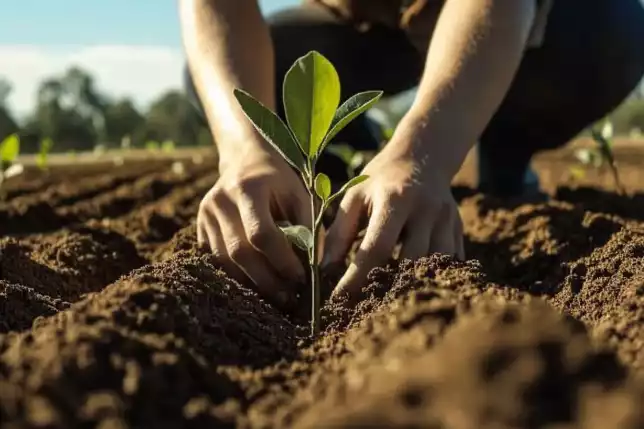How to plant and care for fig trees—Fig trees make a rewarding addition to any home garden, offering both delicious fruit and aesthetic appeal. This guide covers everything you need to know about planting and caring for fig trees, from selecting the right variety to maximizing your harvest.

1. Choosing the Right Fig Tree Variety
The first step in growing figs is selecting the right variety for your garden. Fig trees come in many types, and choosing the right one depends on your climate and space availability.
Popular Varieties:
- Brown Turkey: Known for its hardiness and high fruit yield.
- Black Mission: A sweet variety popular in warm climates.
- Celeste: Great for colder regions and known for producing smaller but sweet fruit.
Pro Tip: Choose a variety that matches your climate to ensure the best growth and fruit production.
2. Where to Plant Your Fig Tree
Finding the perfect location for your fig tree is essential for its growth and fruit production. Fig trees thrive in sunny spots with well-drained soil.
Ideal Growing Conditions:
- Sunlight: Fig trees need at least 6-8 hours of direct sunlight daily.
- Soil Requirements: Well-drained, loamy soil is ideal for healthy root growth.
- Space: Ensure you have enough space to accommodate the tree’s growth—either in the ground or a large container.
Explore more tips on container gardening with fruit trees.
3. Planting Your Fig Tree
Now that you’ve chosen the variety and location, it’s time to plant your fig tree. Whether planting directly in the ground or in a container, this step-by-step guide will help you get started.
How to Plant:
- Spacing: Plant fig trees about 10-15 feet apart if in the ground, or use a container at least 18-24 inches wide for container planting.
- Depth: Dig a hole deep enough to cover the root ball without burying the trunk.
- Container Growing: If space is tight, fig trees grow well in containers. Make sure the container has good drainage and use high-quality potting soil.
External Resource: For more planting tips, check out Gardener’s World guide on growing figs.

4. Caring for Your Fig Tree
Once planted, fig trees need consistent care to thrive. Proper watering, mulching, and fertilizing are key to healthy growth and fruit production.
Care Tips:
- Watering: Fig trees need regular watering, especially in dry periods. Keep the soil moist but not waterlogged.
- Mulching: Apply mulch around the base of the tree to retain moisture and regulate soil temperature.
- Fertilizing: Use a balanced fertilizer in the spring to encourage growth. Avoid over-fertilizing as this can reduce fruit production.
5. Pruning and Training Your Fig Tree
Pruning is essential for keeping your fig tree healthy and productive. Proper training techniques can also help manage the size of the tree, especially in small spaces.
Pruning Techniques:
- Shape Pruning: Prune in late winter to shape the tree and remove any dead or damaged branches.
- Training: If space is limited, consider training your fig tree against a wall (espalier) to save room while maximizing sun exposure.
6. Harvesting and Storing Figs
Knowing when and how to harvest your figs ensures you get the best flavor from your fruit. Proper storage also helps keep them fresh longer.
Harvesting Tips:
- Ripeness: Figs are ready to harvest when they droop slightly and feel soft to the touch.
- Harvesting Technique: Gently twist and pull the fruit to avoid damaging the branches.
Storing Figs:
- Short-Term Storage: Figs can be stored in the fridge for up to a week.
- Long-Term Storage: Figs can be dried, frozen, or canned for long-term use.
7. Troubleshooting Common Fig Tree Problems
Even with the best care, fig trees can face challenges. Here’s how to handle common issues such as leaf curl, pests, and diseases.
Common Problems:
- Leaf Curl: Often caused by underwatering or pests like aphids.
- Pests: Birds, ants, and aphids are common problems for fig trees. Use organic solutions like neem oil to control pests.
- Poor Fruit Production: This can be due to insufficient sunlight, poor soil, or improper pruning.
8. Improving Fruit Production
If your fig tree isn’t producing as much fruit as you’d like, there are ways to improve yield and quality. Here’s how to maximize your harvest.
Tips for Boosting Production:
- Pollination: Fig trees generally don’t need external pollination, but improving airflow around the tree can help.
- Fertilization: Apply a high-phosphorus fertilizer in the spring to encourage fruit development.
- Pruning: Regular pruning encourages new growth and can improve fruit yield.
9. Dealing with Pests and Diseases
Fig trees can be susceptible to certain pests and diseases. Managing these issues early will help keep your tree healthy and productive.
Common Pests and Diseases:
- Fig Mosaic Virus: This can cause yellowing of leaves. Remove infected leaves and prune affected areas.
- Aphids and Ants: Organic solutions like neem oil or insecticidal soap can help control these pests.
Frequently Asked Questions
Q: Can fig trees grow in containers?
A: Yes! Fig trees thrive in containers as long as they have proper drainage and a large enough container.
Q: How much sun do fig trees need?
A: Fig trees need 6-8 hours of direct sunlight daily for optimal growth and fruit production.
Q: How long does it take for fig trees to produce fruit?
A: Fig trees usually start producing fruit in 2-3 years, but this can vary depending on the variety and care.
Conclusion
Growing fig trees in your garden is a rewarding experience that can provide you with delicious, homegrown fruit. By choosing the right variety, giving it proper care, and following pruning and harvesting techniques, you’ll be enjoying fresh figs in no time!


1 thought on “How to Plant and Care for Fig Trees in Your Garden”